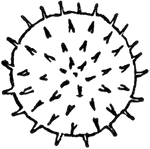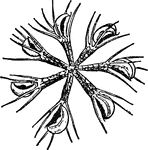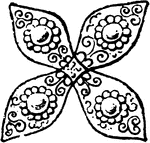
Tortricina
"The Tortricina include a great number of small moths exceedingly injurious to orchard and other trees.…
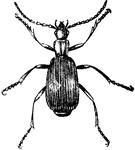
Bombardier Beetle
"These congregate together under stones, and when disturbed discharge a caustic fluid of an extremely…

Crown
"The crown of Henry III has a plain circlet heightened with trefoils, a slightly raised point intervening…

Crown
"The truly beautiful crown of Edward II as it is represented in his effigy, was formed of four large…
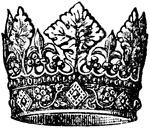
Crown
"It would seem from the crown, sculptured with elaborate care upon the head of his effigy at Canterbury,…

Bennets Electroscope
"The gold leaves are gummed on the two sides of a flat piece of metal carried by a stout stem, which…

Heath
"Erica cinerea. The English form of a name given in most Teutonic dialects to the common ling or heather,…

Heath
"Calluna Vulgaris. The English form of a name given in most Teutonic dialects to the common ling or…
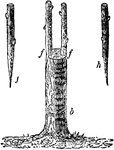
Crown-Grafting
"Crown-grafting is preferable to cleft-grafting, inasmuch as it leaves no open spaces in the wood. The…
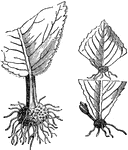
Leaf Cuttings
"Many plans may be propagated by planting their leaves or portions of their leaves as cuttings, as,…
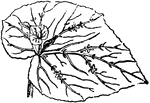
Leaf Cuttings
"Many plans may be propagated by planting their leaves or portions of their leaves as cuttings, as,…
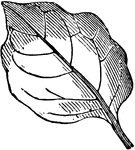
Repand Leaf
Wavy; tending to be sinuate, but less even; undulate; said chiefly of leaves and leaf margins.
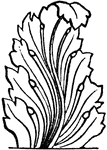
Acanthus
"The name given by the Greeks and Romans to the plants sometimes called Brancursine, of which it is…

American Aloe
Stiff plants with large, thick leaves. It is said to have medicinal purposes for burned or damaged skin.

Allaria Officinalis
"Allaria officinalis. a, upper part of stem, with leaves and flowers; b, extremity of a branch, in fruit."…
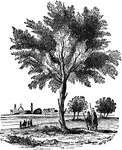
Almond Tree
"A genus of the natural orer Rosaceae, sub-order Amygdaleae or Drupaceae, consisting of trees or shrubs,…

Amaranth
"A genus of plants of the natural order Amaranthaceae. This order contains nearly 300 known species,…
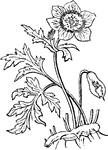
Anemone Coronaria
"A genus of plants of the natural order Ranunculaceae, having an involucre of three divided leaves,…

Angelica
"A genus of plants of the natural order Umbelliferae, by some botanists divided into two: A., and Archangelica.…

Araucaria Imbricata
"Araucaria imbricata: End of a branch, much reduced, showing the mode of ramification, and the manner…

Arbor Vitae
"A genus of plants of the natural order Coniferae, allied to the cypress, and consisting of evergreen…

Arnica Montana
"A genus of plants belonging to the natural order compositae, sub-order Corymbiferae. The flowers of…

Arum Maculatum
"Arum maculatum. a, leaves and root; b, spathe, with base of spadix exposed; c, fruit." — Chambers'…

Asarabacca
"A plant of the natural order Aristolochiaceae, a native of Europe, growing in woods; rare, and perhaps…

Common Ash
"Common Ash. a, a branch with leaves; b, flowers; c, fruit (on a considerably larger scale than the…
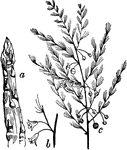
Asparagus
"Asparagus. a, a young shoot; b, flowers; c, the upper end of a stem, showing branches, leaves, and…
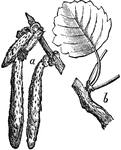
Aspen
"A tree which grows plentifully in Europe and in Siberia. It is a native of Britain, and is frequent…

Astragalus
"A genus of plans of the natural order Leguminosae, sub-order Papilionaceae. The pod is more or less…

Astrocaryum
"A genus of Palms, of which about sixeen species are known, natives of tropical America, remarkable…

Balsam
"Balsam (Impatiens Noli-me-tangere). a, top of stem with leaves and flowers; b, ripe fruit unopened;…

Batatas
"A perennial plant with long creeping stems, heart-shaped leaves on long stalks, and variously lobed,…
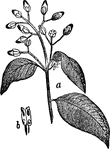
Cinnamon
"Cinnamon: a, end of branch, with leaves and flowers; b, four-celled anther." — Chambers' Encyclopedia,…

Convolvulus
"Convolvulus: a, part of stem with leaves and flower; b, a flower-stalk and flower, the corolla and…

Copaiva Tree
"A valuable medicinal substance, consisting chiefly of a resin (Resin of Copaiva) and a volatile oil…
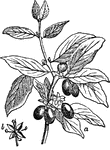
Cornel
"Cornel: a, a branch with leaves and fruit; b, a single flower." — Chambers' Encyclopedia, 1875
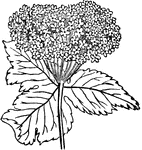
Cow Parsnip
"A genus of plants of the natural order Umbelliferae, having petals bent in at the middle, and flat…
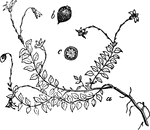
Cranberry
"Cranberry (Vaccinium palustris): a, part of stem and branches, with roots, leaves, and flowers; b,…
Crockets
"In Gothic Architecture, are projecting leaves, flowers, or bunches of foliage, used to decorate the…

Crockets
"In Gothic Architecture, are projecting leaves, flowers, or bunches of foliage, used to decorate the…

Crowberry
"A small procumbent shrub, of the natural order Empetraceae, a native of the northern parts of the world,…

Crown
"Crowns were originally garlands of leaves; and in this form they have probably been used as an ornament…

Crown
"Crowns were originally garlands of leaves; and in this form they have probably been used as an ornament…
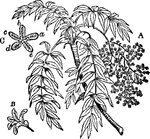
Cusso
"Cusso: A, a branch, with leaves and flowers; B, a flower seen laterally; C, a female flower; a, b,…
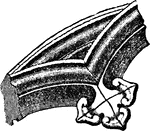
Cusp
"Cusp, in architecture, is the point formed by the meeting of two small arches, or foils, in foil arches,…
Darnel
"A grass of the same genus with the valuable Ryegrass, an annual, common in the cornfields in England…

Dogbane
"Dogbane. a, end of branch, with leaves and flowers; b, a flower cut open; c, fruit." — Chambers'…
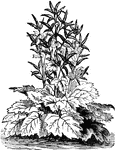
Medicinal Rhubarb
A perennial plant with many short red stems and green leaves. Commonly used in cooking.

Common Elder
"Flower-stock, Leaves, and cluster of Berries of the Common Elder (Sambucus nigra)." — Chambers'…

Black Pepper
"A genus of order Piperaceae. The Piper nigrum, which furnishes the black pepper of commerse, is a native…
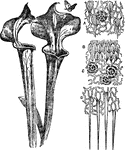
Sarracenta
"Leaves of Sarracenta purpurea. A, attractive surface of lid; B, conducting, C, glandular, and D, detentive…

Cephalotus
"Cephalotus follicularis, showing ordinary leaves and pitchers, the right hand one cut open to show…

Pitchers
"Morphology of Pitchers. A, ordinary leaf of Cephalotus; B, monstrous leaf with spoon-shaped depression;…

Jasmine
"Botanically Jasminum, a genus of shrubs or climbers constituting the principal part of the natural…
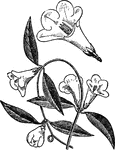
Gelsemium
"The plant known in America as the "Carolina jasmine" is not a true jasmine. other hardy species commonly…

